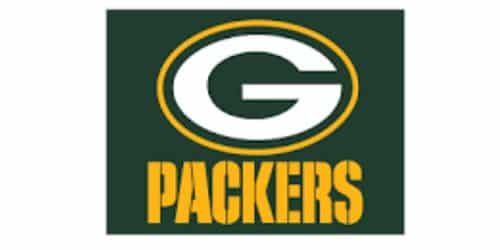The Green Bay Packers are one of the oldest members of the NFL. If Earl “Curly” Lambeau, the founder of the Green Bay Packers, is still alive to date, he will marvel that the team born out of passion is now one of the best teams in the history of the NFL. The Green Bay Packers logo, uniform, and colors uphold the tradition and the richness of their history in a modern way. Their logo is a simple capital “G”, which is the first initial of their name. It is one of the simplest logos ever in the history of the NFL. Like other teams in the NLF, the Packers have their own dose of struggles, challenges, and achievements, which tells the rich story of their evolution. The question is, how well do you know the Packers?
Green Bay Packers Logo
The present logo for the Green Bay Packers is a simple, clean badge that consists of a dark green oval with a white capital “G” repeated around its perimeter. The oval is oriented horizontally, and the “G” is repeated around the oval. The letters were designed using a sans-serif typeface that was both clean and bold. Additionally, the letters have neat and sleek contours. White, green, and yellow make up the three colors that make up the logo.
Each one of these elements represents something that is extremely valuable to the team as a whole. The Green Bay Packers’ logo features a dark green color that is meant to represent the team’s expansion and success. It has white and yellow colors. The white is meant to represent the club’s dedication to its supporters, while the yellow color is meant to add a sense of vitality and happiness to the overall composition.
The current logo for the team, which was made in 1980, was used to design the new one.
What Does the Green Bay Packers Logo Mean?
The “G” on the Packers’ logo stands for Green Bay. The letter “G” is the first initial of the team’s name. As a result, it is only natural that it refers to the Green Bay Packers. However, rumors have it that it has another meaning, “greatness.” The team did not officially dispel this as false either. However, the letter, its shape, and the color of the Green Bay Packers logo all have significant meanings. For example, the logo includes a dark green color to represent the team’s growth and success, a white color to represent the club’s dedication to its supporters, and a yellow color to add vitality and happiness to the overall composition.
The logo was designed using the colors dark green, yellow, and white. These colors were chosen to represent tenacity, competitiveness, excellence, and strength. The yellow line has an encouraging and motivating effect on the viewer.
Because color is so important in logo design, the color palette was chosen in such a way that each shade works in harmony with the others. The gradual change from white to dark green makes the two colors stand out from each other. A yellow stripe, which first appeared in the year 1980, adds a splash of color.
Who Designed The Green Bay Packers Logo?
The first “G” logo was made by Gerald “Dad” Braisher and John Gordon, a St. Norbert College student who worked for him. The duo invented the famous “G,” gave it a shape, and meticulously worked out the details.
Green Bay Packers Shape
The primary Green Bay Packers logo used today is the same white “G” on the same green oval background as it was in the past. However, this time it has a yellow border around it. It is highly likely that this was done so that the logo could be placed on the players’ helmets. This particular iteration of the logo was approved in the year 1980 and is still in use to this day.
Green Bay Packers Logo Colors
The Green Bay Packers logo primarily has three colors. These are yellow, white, and green. Because color plays such an important role in the design of a logo, the color palette was selected in such a way that each shade works in harmony with the others. The gradual transition from white to dark green is what produces the contrast between the two colors. A splash of color is provided by a yellow stripe, which made its debut in the year 1980.
#1. Yellow
Yellow is an upbeat, youthful color that gives off a sense of hope and positivity. For the team, it is another color that is sure to grab people’s attention.
#2. Green
The color green, on the other hand, is extremely prevalent in nature and is associated with the concept of expansion. Think about the staggering number of different shades of green that convey rebirth and life in the natural world. The color green is representative of plenty and is linked to feelings of renewal, tranquility, rest, and safety. The color green has a revivifying and calming effect on people.
#3. White
White is a color that has a naturally positive connotation. In general, it is linked to ideas like cleanliness, virginity, innocence, light, goodness, heaven, security, brilliance, illumination, and many other good things.
The colors dark green, yellow, and white were chosen to be used in the logo. These colors were chosen because they represent tenacity, eagerness to win, excellence, and strength. The yellow line has an effect that can be described as encouraging and motivating.
Green Bay Packers Logo History
The Green Bay Packers changed their name from the Acme Packers to the Green Bay Packers in 1937. In the same year, the team’s logo underwent its first modification. In 1955, despite keeping the same name, the team went through yet another complete rebranding of its emblem. This time, the focus is on a football, or soccer ball, which went through a number of changes before being drawn as a stylized letter G. At first glance, it seemed quite plausible. On the side, there was a display of the state of Wisconsin as well as the player who was wearing the number 41 jersey.
The emblem has undergone a dramatic transformation. The ball is still there, but it has taken on a more abstract appearance now, taking the form of an inverted dark green oval that is surrounded by a yellow outline. On the inside, the letter “G” is shaped like an oval as well.
1921
The Green Bay Packers were launched on August 11, 1919, but one can trace their first logo to 1921. The first logo used by the Green Bay Packers, which was introduced in 1921, was quite simple. The logo did not feature anything that was particularly interesting or unique. It just has the team’s name written in different fonts on a white background, which is way too simple. Acme Parking was the name of the team when it first played in 1921, not the Green Bay Packers. Acme Packers were the name on the wordmark logo when it was first used in 1921, not Green Bay Packers.
When this wordmark is printed on clothing, it looks like a chevron instead of a regular typeface. This time, it takes the form of an oblong rectangle with rounded corners. It has two black stripes that are outlined in white, and in the middle, there is white space.
It was written in stern, bold lettering that was set in two levels, with both levels being yellow and having a thick green outline around them. Even though the writing was simple, the shadowed border around it gave it a sense of strength and confidence.
1937 – 1955
After the team was renamed the Green Bay Packers in 1937, there was a need for a new logo. So the club came up with the square and bold “GB” monogram. This was the first year that the Packers won the Super Bowl. The lettering was done in a geometric typeface, with the contour of the letter “B” being narrowed and the contour of the letter “G” being horizontally stretched. The new color scheme for the company’s logo featured a light gray for the letter outlines and a dark blue for the bodies of the letters.
1951 – 1955
During this time, green became the most important color in the Green Bay Packers’ well-known logo. This should not have been a shock in any way, especially considering that they go by the name Green. In 1937, everyone agreed that it was an excellent choice. The Green Bay Packers used an orange football with a yellow outline as their logo in 1937. The logo was placed in between two orange goalposts. When it first came out in 1951, the original Green Bay Packers logo was meant to represent tenacity, excellence, competition, and the never-ending pursuit of victory. In addition to that, there is a large print wordmark that reads “Packers” with a capital “P” at the beginning.
The background is a large football with two white stripes and lace. It takes up most of the screen. Because there are no borders or other outlines, only white is present, which suggests a wide variety of potential activities. In addition to the changes already mentioned, the first letter of the wordmark “Packers,” which is written in bold sans-serif and all capital letters, was made bigger. The inscription was done in a dark green color with a thin yellow outline, and it was placed on a background that featured a football in red and yellow that was placed at a slight diagonal. The colors of the logo were balanced by the addition of four thin red stars in the shape of a cross on both sides of the ball.
1956 – 1961
The Green Bay Packers unveiled their new team logo in 1956. It was a yellow football that stood up straight and had a green outline of the Wisconsin State emblem on it. There was a football player who wore the number 41 and was dressed in a yellow uniform with green accents. He was depicted with a yellow football and a green background when the image was displayed. It was a charming and memorable logo. Unfortunately, it was only used by the club for a total of six years. He assumes a stance similar to that of a thrower and gets ready to throw. The state of Wisconsin is depicted in green in the background, and a green star is centered within a white circle (Green Bay city).
Yellow is the primary color of the player’s uniform, which contrasts with the player’s white football-style helmet, socks, and shirt number. Also, there is a bigger football in the logo, and it has two fine lines that make it stand out. Using key elements, the designers were able to show how important American football is to the people of Wisconsin. The primary version of the logo was preceded by this one.
1961 – 1979
In 1961, the Green Bay Packers debuted a brand new, one-of-a-kind logo that stood out from the crowd of other sports teams’ emblems.
This time around, the logo is designed to look like a miniature badge and consists of an English “G” in the shape of an oval that is shaped like a football.
The letter was designed using a sans-serif typeface that was both clean and bold, and it had neat and sleek contours. The new Green Bay Packers logo features a dark green color that stands for the team’s expansion and success, while the white color stands for the club’s commitment to its supporters.
Gerald “Dad” Braisher, who was in charge of the Packers’ equipment, added this part to the logo that Lombardi asked him to make. The task was given to John Gordon, an art student at St. Norbert College, by Braisher After they had reached a point where they were satisfied with the “G” in the shape of a football, they presented it to Lombardi, who gave his approval for the addition.
1980 – Today
1980 was the first year that the current Green Bay Packers logo was used. However, many people think that the year 1961, when the emblem was first introduced with a white letter “G” against a dark oval background, is the actual year that it was first created. The logo that was used in 1961 was altered, and the designers accomplished this by surrounding the oval with a broad yellow line.
The first version of the logo was designed by Gerald “Dad” Braisher and John Gordon, who was a student at St. Norbert College at the time. They came up with the famous letter “G,” gave it a form, and laboriously figured out the details of its design.
The yellow outline of the letter “G,” which is reminiscent of earlier iterations of the club’s logo, adds a sense of vitality and joy to the overall composition. In spite of this, the club continues to use the older badge (which does not have an outline) on the helmets it issues.
Green Bay Packers
The American football team, the Green Bay Packers, plays at a professional level. The Green Bay Packers call Green Bay, Wisconsin, their home field. It was founded in 1919, making it the third-oldest team in the National Football League. Earl “Curly” Lambeau and George Whitney Calhoun started the team in 1919, but its roots go back to semi-professional teams in Green Bay as early as 1896. The Green Bay Packers compete in the National Football Conference North division as part of the National Football League (NFL). This division is part of the National Football Conference. Additionally, it is the only major league professional sports team in the United States that is owned by the community and does not operate to make a profit. Since it opened in 1957, Lambeau Field has been the site of home games for the Green Bay Packers.
The club is distinct in the modern era because it is owned by the public and has 360,584 stockholders (as of 2015 data). Additionally, there is a free float that accounts for 4% of the franchise. Regular people have been giving in this way to support the team for the better part of a century. Because of this, no one knows who owns the team, and the franchise makes money because it is considered public property.
Lambeau was joined on the list of owners by Gerald Clifford, Leland Joannes, Webber Kelly, and Andrew Turnbull during the second half of 1922. This was the status of the franchise up until the year 1935. The franchise came into the sole possession of the general public after an organization with the same name bought up all of the rights to it.
Founded: August 11, 1919
Founder: Green Bay Packers, Inc.
Headquarters: Green Bay, Wisconsin, U.S.
Green Bay Packers History
Curly Lambeau, the founder of the Green Bay Packers, wanted to start a local football team in Green Bay, Wisconsin, in 1919. Unfortunately, he doesn’t have the resources to actualize his goal. Luckily, he had a network, and he maximized it. At the time, Lambeau worked as a shipping clerk for Indian Packing and decided to ask for money. He found a way to persuade his employer to sponsor his new football team. To that end, the Green Bay Packers were born. As of then, it has been difficult to recall what the team used as their logo. This is because the first record of their logo available on the internet is that of Acme Packers. So, in August 1919, the Indian Packing Company agreed to sponsor a local pro football team led by Earl (Curly) Lambeau. The Packers were granted membership in the new National Football League in 1921.
After persuading Indian Packing, the company agreed to sponsor the team by giving the players uniforms, paying for the club to get started, and letting the team practice on its football field. In thanks for the company’s support, the team added “Packers” to its name to help promote itself.
Presently, Lambeau’s dream is the third-oldest team in professional football. Up until not too long ago, the Green Bay Packers’ long and storied history was one of struggle. The team’s history would not be complete without talking about how it managed to stay in business and play well. However, the Packers’ record has been marked by high points of success as well as low points of defeat.
Green Bay Packers Major Accomplishments
As one of the oldest members of the United States’ NFL team, Green Bay has a good number of accomplishments. This includes the Super Bowl, the NFC, and so on. Check out the year of this accomplishment below;
- Super Bowl Championships: I, II, XXXI, XLV
- NFC Championships: 1996, 1997, 2010
- NFL Championships: 1929, 1930, 1931, 1936, 1939, 1944, 1961, 1962, 1965, 1966, 1967
- NFL Western Conference Championships: 1936, 1938, 1939, 1944, 1960, 1961, 1962, 1965, 1966, 1967
- NFC Central Division Championships: 1972, 1995, 1996, 1997
- NFC North Division Championships: 2002, 2003, 2004, 2007, 2011, 2012, 2013, 2014
Facts You Should Know About Green Bay Packers
How well do you know one of the oldest National Football League (NFL) franchises? Check out the following Green Bay Packers facts:
- The current season ticket wait time is 40 years. There are approximately 83,881 names on the waiting list.
- In 1966 (I), 1967 (II), 1996 (XXXI), and 2010, the Green Bay Packers won the Super Bowl (XLV).
- Prior to the 1970 merger of the AFL and NFL, the Green Bay Packers won the NFL Championship 11 times, in 1929, 1930, 1931, 1936, 1939, 1944, 1961, 1962, 1965, 1966, and 1967.
- The Green Bay Packers appeared in 30 playoff games as of the 2014 game. The others include 1936, 1938, 1939, 1941, 1944, 1960 – 1962, 1965 – 1967, 1972, 1982, 1993 – 1998, 2001 – 2004, 2007, and 2009 – 2014.
- From 1919 to 1922, the Green Bay Packers played at Hagemeister Park, Bellevue Park from 1923 to 1924, City Stadium from 1925 to 1956, and Lambeau Field from 1957 to the present.
- In the twentieth century, the Green Bay Packers had 13 coaches. The includes Curly Lambeau (1921-1949), Gene Ronzan (1950 – 1953), Hugh Devore (1953), Ray McLean Vince Lombardi (1959-1967), Phil Bengtson (1968-1970), Dan Devine (1971-1974), Bart Starr (1975-1983), Forrest Gregg (1984-1987 (1999),
Other Facts About Green Bay Packers
- In the twentieth century, four former Green Bay Packers players had their numbers retired: Tony Canada (#3) in 1952, Ray Nitschke (#66) in 1983, Bart Starr (#15) in 1973, and Don Hutson (#14) in 1951. Because the NFL does not allow numbers to be retired, the Packers retired Reggie White’s jersey in 1999 rather than his number, which was #92.
- Reggie White was the Green Bay Packers’ first free agent signing. Reggie was the most sought-after free agent at the time.
- Russ Letlow was the Green Bay Packers’ first draft pick in 1936. In 1972, he was inducted into the Green Bay Packers Hall of Fame.
- When the Green Bay Packers won the Super Bowl in 1966 and 1967, Vince Lombardi was their coach.
- The Vince Lombardi Trophy is the name given to the NFL Super Bowl trophy.
- There are 153 people in the Green Bay Packers Hall of Fame. Curly Lambeau, Don Hutson, Russ Letlow, Vince Lombardi, Max McGee, Forrest Gregg, Greg Koch, and Ahman Green are among the members.
- Curly Lambeau, Robert Hubbard, Don Hutson, Johnny Blood McNally, Clarke Hinkle, Vince Lombardi, and many other Green Bay Packers players have been inducted into the Pro Football Hall of Fame.
Why Do The Packers Have a G on Their Helmets?
In 1961, the Packers’ team equipment manager under legendary coach Vince Lombardi created the team’s helmet logo. He created the logo’s shape to represent a football and the G to represent the Green Bay Packers. However, many people argue that the G on Green Bay Packers helmets means greatness and not the team’s name like the logo.
Why is the Packers Logo Just a G?
The Green Bay Packers logo is just a G. The G, on the other hand, is simple, but it hides the team’s deep value and secrets. First, it is the first initial of the team’s name. Secondly, anyone who sees the G will immediately relate it to the Green Bay Packers team.
When Did the Packers Change From Blue to Green?
Lambeau was forced to resign from the team in 1949, and the Packers’ colors were changed thereafter. Navy blue was retained as a secondary color, but it was later removed from the team color list on all official materials shortly thereafter. In 1959, the club decided that green and gold would be its official colors from then on. Ever since then, green and yellow have been the official colors of the Packers. This was the year that Vince Lombardi began his first season as head coach. However, this does not imply that the Green Bay Packers did not play in the color combination of green and gold during their first 40 years.
Why Do Green Bay and Georgia Have The Same Logo?
Even though the Georgia football team is not affiliated with the Green Bay Packers, they are allowed to use a logo that is very similar to the Packers’ logo. This permission was given to Georgia by Green Bay. However, Georgia G’s dimensions and color scheme are not the same as those of the professional football team. To make use of the logo, the university requested authorization from Green Bay. Aside from Georgia’s football team, Grambling State is another team that uses the G logo. They, too, used the logo only after receiving permission from Green Bay to do so.
Do the Georgia University Pay Green Bay PackersTo Use The G Logo??
No, Georgia University does not pay the Green Bay Packers to use the G logo. The “forward-looking “G” has been used by the Bulldogs ever since 1964 when new football coach Vince Dooley added the logo to Georgia’s helmets. Since then, the “forward-looking ‘G'” has been utilized by the Bulldogs.
Why Is It Called Green Bay?
Green Bay is the city that saw the birth of the football team. It was a common practice for a sports team to take its name from the municipality in which it was headquartered in the nineteenth century. In the state of Wisconsin, in the United States, the town of Green Bay is located in Brown County. Jean Nicolet, a French explorer, arrived in the region in the year 1634 and gave it the name “La Baye Verte,” which translates to “The Green Bay,” because of the emerald hue of the water. When a fur-trading post was first set up there in 1655, Green Bay became the starting point for a trade route that linked the rivers Fox, Wisconsin, and Mississippi. The team only added “Packers” to its name because the Indian Packings were its sponsor when they began.
When did the Packers Put The G on Their Helmet?
The “G” logo helmet was launched by the Green Bay Packers on August 5, 1961. This was during the Packers’ annual intra-squad game that took place on August 5, 1961. The Green Bay Packers put their now-iconic “G” logo on their helmets for the first time on August 5, without any fanfare or advance notice.
Which Team Had The G Logo First?
The Green Bay Packers were the first team to use the oval “G” as its logo. In the United States, there are three teams that use the G logo. These are the Green Bay Packers, the Georgia University football team, and the Grambling State University team. Both Georgia University and Grambling State University sought the Green Bay Packers permission before using the G logo.
Conclusion
The Green Bay Packers logo may be simple, but it has a touch of modern design in its simplicity. To date, the logo stands out from other teams’ logos.
- NFL LOGO: Meaning, Evolution, and History
- CLEVELAND GUARDIANS LOGO: History, Ideas, Evolution, Meaning
- BREWERS LOGO: What Is Hidden in the Milwaukee Brewers Logo, Meaning and History
- PYTHON LOGO: Who Designed the Python Logo and Its Meaning






